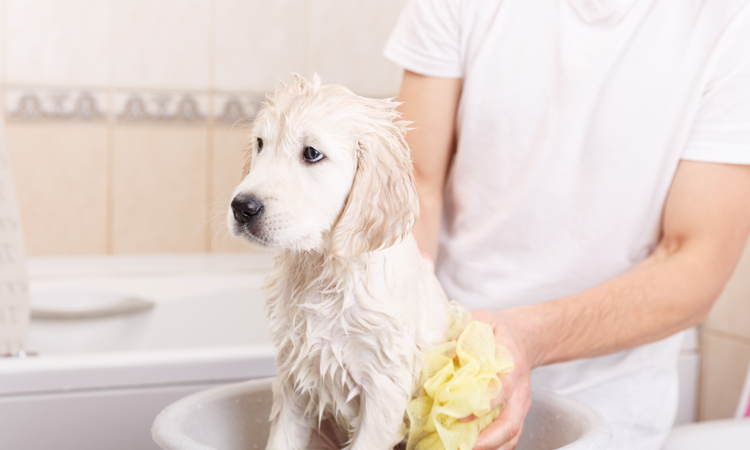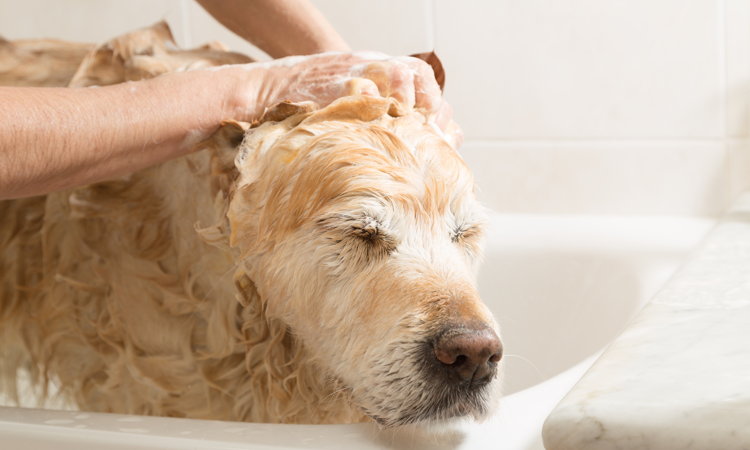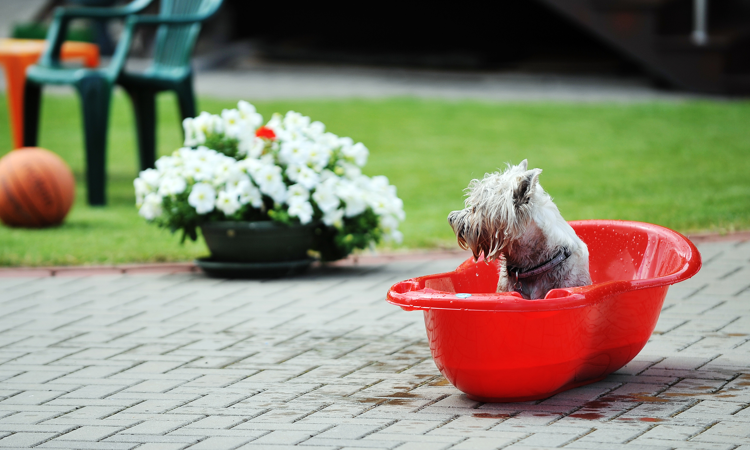There was a time when the idea of washing a dog was simply unheard of – dogs were smelly and that was the end of it. Gradually, as we’ve domesticated our four-legged friends to the point where it’s totally acceptable for them to wear snazzy costumes and share our pillows, the occasional shower doesn’t seem like such a bad idea. In fact, it’s no longer a question of “should I wash my dog?” – it’s “how often should I wash my dog?” And the questions don’t often end there, either.
Once you’ve decided that you might need to give your pooch a regular wash, then there comes the issue of actually getting through bathtimes without find yourself soaked from head to toe and chasing a sopping wet dog around the house.
So, how often do you bathe a dog?
Unfortunately, this question doesn’t come with a one-breed-fits-all answer. How often you wash your dog depends on the following things; breed, lifestyle, skin condition and whether your dog actually enjoys bathing or not.
Shortly after you bring your dog home for the first time, it’s usually a good idea to pay a visit to your vet. They can give you lots of advice and introduce you to some of the things you will need to know as a new dog owner.
Ask your vet how often they think you should wash your dog and explain your concerns to them. They can also recommend dog grooming products that would benefit your dog’s specific coat and skin type, as well as give you advice on vaccinations, diet, exercise, general grooming, flea and tick treatments – many of these healthcare treatments will vary greatly depending on your dog’s breed, age, size and lifestyle.

Puppies shouldn’t need to be washed too soon after you bring them home for the first time, which is usually around the eight-month-old mark. A puppy’s mother will usually clean her pups by licking them with her tongue so you can simulate this experience with a flannel and some warm water. When you introduce water it’s a good idea to do this very gradually – don’t use shampoo until your dog is over twelve weeks, but it’s a good idea to introduce your dog to lots of different experiences, including being bathed, during what’s known as the puppy socialisation window. This is between the ages of eight and twelve weeks old.
You only need to bathe your puppy or adult dog when they are noticeably dirty or smelly but getting a puppy used to water from a young age, will pay-off later down the line. To do this, keep water fun and start gently. For your dog’s first wash, use a bowl of warm water and a flannel, as opposed to putting your dog in the bath or shower. When your puppy is a little older and ready for the tub, use a non-slip bath mat so they feel more secure and aren’t slipping all over the place.
Whether you have been advised to wash your dog once a week, once a month to four times a year, will depend on your dog’s breed, skin type and how close quartered they are with you and other family members. For instance, if your dog shares a bed with you every night, you’ll probably want to wash them more often than if they actually slept downstairs on that expensive dog bed you bought them three years ago…
Regardless of those factors, there is a general rule of thumb for obvious breed differentiations and these are mainly based on a dog’s coat type.
How often do different dog breeds need bathing?

When it comes to frequency, we’d advise you to err on the side of less-is-more. Your dog’s coat holds important natural oils and over-washing can strip these oils, irritate the skin and cause dryness and itching. If the problem persists, this can cause open wounds in your dog’s skin and lead to infection. Another reason why choosing the correct shampoo and conditioner is vital when it comes to home grooming.
Smooth coat dog breeds
Dogs breeds including Beagles, Bull Terriers, short-haired Dachshunds, Greyhounds and other smooth coated dogs need minimal bathing and, if they spend most of their time indoors and are regularly brushed, three or four baths a year is perfectly adequate.
If your dog is prone to seeking out the biggest, muddiest puddle on every walk and needs a regular post-walk clean-up, we’d advise keeping a towel in your car and by your front door so you can rub off any excess mud and moisture immediately. You shouldn’t wash your dog daily or weekly but you can minimise the damage by toweling your dog off and then giving them a thorough brush once they are fully dry. Deodorising sprays are also really handy for use on pongy dogs, between washes.
Double coat dog breeds
Dogs like Labradors, Rottweilers, Chows, Huskies and Collies have beautiful double coats that benefit from daily brushing. Bathing wise, double coated dog breeds are fine with an ‘as-and-when-needed’ approach to bathing – unless your vet advises otherwise. The priority with these breeds is regular brushing. Give them a bath if they roll in something unpleasant or generally smell a bit whiffy but try to brush them at least twice a week regardless.
Wire-haired dog breeds
Think Irish Terriers, Jack Russells, Airedale Terriers, Miniature Schnauzers and others. These dogs have a clever combo-coat with a short, soft undercoat and wiry guard hairs, means wire-haired dog breeds wear their own waterproof jacket all year-round. Brush a couple of times a week and bathe wire-haired dog breeds every two months or so.
Curly coat dog breeds
This category includes Poodles, Bichon Frises, Labradoodles, Cockerpoos, Irish and Portuguese Water Spaniels have gained popularity in recent years because of their low-shedding tightly curled coats. Don’t be fooled into thinking that because they don’t shed, caring for their coat will be a breeze. Caring for curly-coated breeds involves regular brushing, detangling and the occasional bath. When it comes to bathing, every two months should be more than enough.
What is that smell? Oh, it’s you…

Regardless of the breed and how agreeable your dog is to the idea of a bubble bath, there are days when your dog will seek out the stinkiest, muddiest stream in the world, or take inexplicable joy in rolling over and over a huge pile of duck or fox poop until they consider themselves suitably plastered.
Interesting fact: Did you know that dogs used to coat themselves in mud or muck on pack hunts? It was a tactic to mask their own scent on the approach to a kill – smart doggies! Many of today’s domesticated animals still do this out of instinct and there are some days when there’s just no stopping them.
So, for whatever reason your dog is due a bath, there are ways to make it easier for everyone – yourself included.
How to wash your dog: a step-by-step guide
It pays to train your dog to be relaxed around water from a young age but, if you’ve got yourself a surprisingly agile and fully-grown aquaphobic hound, these tips should help:
Preparing your at-home groom room
- Choose your grooming products carefully – you don’t need to spend a fortune and there are lots of lovely natural dog grooming products on the market that can make a huge difference to overly dry or oily coats. If your dog has dandruff or any kind of skin complaint, opt for a medicated shampoo and ask your vet for advice. Don’t use human shampoo – these aren’t suitable for dogs and can dry out their skin.
- Remember you will need a flannel or shower puff ball too – avoid sponges as the fur is tricky to remove from them afterwards.
- Quietly prepare the bathing area and make sure you have plenty of towels and all your grooming products to hand and within easy reach.
- Squeeze a good amount of dog shampoo onto a flannel or shower puff and leave it in an otherwise empty bowl to the side of the bath or shower. This is so there’s no hanging about later, whilst you try to open the bottle with wet hands!
- Consider what you’re wearing. Might you want to do this in your underwear or baggy old t-shirt instead of your good jeans? You’ll thank us later if your dog enjoys a good shake after they get wet.
- Fill a second large wash bowl with warm water and set it to one side with a second flannel – this is for your dog’s face.
- Fill a small plastic tub with bite-size treats and keep these nearby to reward your dog for his efforts.
How-to wash your dog, with minimum stress:
- Encourage your dog into the bathroom and start with a big cuddle and thorough brush – hopefully, this will relax your dog.
- Keep your voice encouraging and fairly level; even if you think absolute carnage is imminent. This will reassure your dog that you are in control of the situation and, even if they are nervous, they will be reminded that they are safe. Don’t be tempted to put on your high-pitched ‘playtime’ voice, as this will encourage your dog to get excited!
- Wash your dog in warm water and test the temperature on your arm before you lift or lead your dog into the bath or shower.
- Once your dog is in the water, wet their fur thoroughly and calmly reassure them as you go. Start from the neck and work your way along their body. Don’t do the face yet and take care not to get water or product into your dog’s eyes, nose or ears.
- Once your dog has been rinsed, rub the pre-prepared washcloth all over your dog and wash him thoroughly – not forgetting the paws.
- Rinse and repeat. You might need to do this a couple of times if you have chosen to use a separate shampoo and conditioner. Give your dog one final rinse all over and then use your separate bowl and flannel to gently wipe across their face and into their creases (especially important if you have a Pug or other short-muzzled breed).
- Use your hands to remove excess water with a firm stroke and then dry your dog thoroughly with a microfibre towel. That’s not to say we’re being divas by the way – the microfibre is super absorbent and makes for a much quicker dry.
That’s it, you’ve done it! Time for a reward – for you and your dog. Always reward your dog after you’ve washed him as it should make things easier in the future. Perhaps a nice relaxing bubble bath for you now. We’d love to hear from you, why not share your own experiences, stories and advice in the comments below.